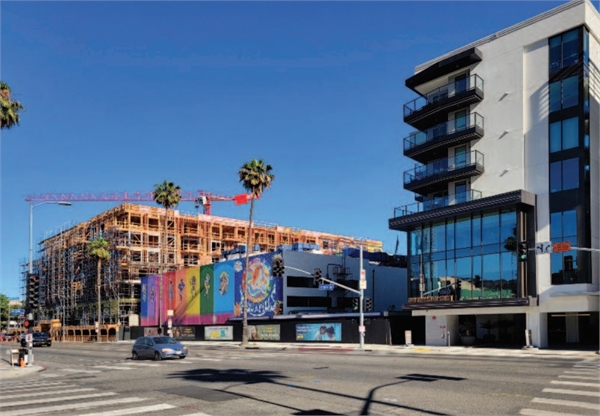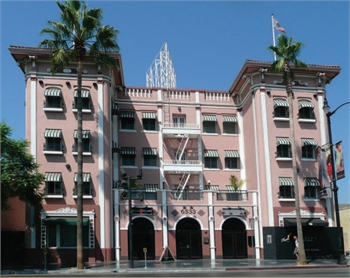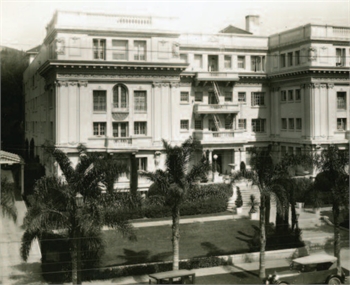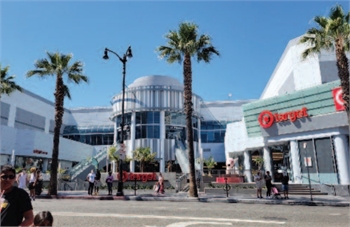No video provided.
Hollywood at a Crossroads

Historic Earl Carroll Theatre is under restoration and now flanked by two major new apartment projects.
Hollywood Heritage issues a Call to Action!
Few American urban main streets have captured the imagination both in the United States and abroad more than Hollywood Boulevard. With its evocations of cinematic glamor, movie stars, and premiers, its reputation projects a well cultivated vision of American success and opportunity. The opportunity to be discovered, to reinvent yourself, to practice art through acting, writing, designing and directing or simply to become a star. With such a legendary renown it can be difficult to imagine Hollywood Boulevard listed on the National Register threatened facing dangers both real and imminent.
The threats confronting the National Register Hollywood Boulevard Commercial and Entertainment District are both recent and longstanding. Battered by a year of the coronavirus pandemic, civil unrest and economic calamity, the loss of retail, restaurants and other businesses has been catastrophic, threatening even legacy businesses such as Musso and Frank’s, Miceli’s and the last bookstore on the boulevard, Larry Edmunds. But the growing pressure of development and new proposed community plan could enshrine these threats in new zoning and planning regulations. Without changes in the proposed plan, erosion of the integrity of the district could occur which will threaten its status as a National Register District.

When first renovated, former Hillview Apartments
(now The Hudson) was a bright spot on The Boulevard.
The effects of the new plan are most felt in the central portion of the National Register District, a low rise and walkable area providing a quieter respite, between the buzzing Times Square like atmosphere of Hollywood and Highland Avenues and the nightlife hub of Hollywood and Vine. These long blocks of low-rise one and two-story buildings are lined with shopfronts, restaurants and bars and make up the heart of Hollywood Boulevard. They connect it to the residential streets to the north and south of the Boulevard and give the district its historic Main Street character. At its center is the G. Albert Landsburgh’s Spanish Renaissance Revival Warner Hollywood Theater, sadly shuttered since 1994, the last unrestored movie palace on Hollywood Boulevard. Even in good times this stretch of the boulevard struggles with a high turnover of tenants, neglected buildings, and poor street lighting.
To protect this historic resource, Hollywood Heritage has created its Vision Hollywood 2021, laying out principles and specifics for how Hollywood Community Plan Update can be amended to fulfill goals for preserving Hollywood’s historic infrastructure. Throughout the U.S. and the world, cities have shown that promoting sustainable re-use of existing buildings, maintaining, and enhancing historic affordable housing, creates livable and enjoyable environments for residents and visitors.
Hollywood Heritage, established in 1980, was instrumental in the survey of historic buildings resulting in the listing of the Hollywood Boulevard Commercial and Entertainment District on the National Register in 1985. When Paramount Pictures moved the first movie studio—an old barn originally located at Selma and Vine—it was Hollywood Heritage who took on the challenge ultimately relocated it opposite the Hollywood Bowl. Known as the Hollywood Heritage Museum, that was the first of its landmark preservation efforts which included the Wattles Mansion and providing input to the restoration of the El Capitan, The Egyptian, and the Pantages Theatres and, most recently, the Earl Carroll Theatre. With the support of the Community Redevelopment Agency and its Hollywood Redevelopment Project, HH supported the professional identification of historic resources producing a list of nearly 1,000 landmarks within Central Hollywood area.

The Hollywood Galaxy (right) was Hollywood Boulevard’s
first new major development. It rose on the site of the
historic landmark Garden Court Apartments
(above) which succumbed to the wrecking ball.
While pandemic restrictions caused a halt to all manner of activities, construction and development in Hollywood continued in earnest. According to the Hollywood Partnership, of a total of 77 projects are slated for the Hollywood area, 38 of which are in the historic core on and around Hollywood Boulevard. At the same time the City of Los Angeles Planning Department pushed forward with its review process for the Hollywood Community Plan Update, which will determine new zoning for Hollywood Boulevard. While a new community plan is necessary to manage Hollywood’s continued growth and need for affordable housing, the plan as written has the potential to threaten the majority of Hollywood’s historic buildings, including many within the Hollywood Boulevard Commercial and Entertainment District.

Of all the Hollywood Community Plan components, the most significant is the “Land Use Plan” which, according to the Hollywood Heritage, has the potential for historic buildings to be razed; and neighborhoods and districts to lose cohesiveness, historic character, and livability.
While the plan itself states, “Hollywood’s renaissance over the past two decades has been spurred by the rehabilitation and adaptive reuse of its remarkable historical resources. From the revitalization of Hollywood’s historical theaters to the conversion of historical commercial buildings to new housing opportunities, historic preservation and rehabilitation has enhanced Hollywood’s authenticity and economic vitality,” it provides a series of goals and policies but little process and implementation. There is no policy which supported such adaptive re-use projects as the Broadway, the Taft and the Equitable Buildings bringing new life to the corner of Hollywood and Vine.
This lack of clarity regarding protections for historic buildings and compatible new design may not protect Hollywood Boulevard’s modest 1920s commercial storefronts nor its more recognizable monuments such as Grauman’s Chinese Theater from the well-funded development threats.

The Janes House, a Queen Anne/Dutch Colonial Revival
landmark from 1903, was moved off Hollywood Boulevard
to make room for a small shopping complex.
Anyone who has worked or lived in Hollywood sees the vast potential—a vibrant Boulevard that preserves historic character for the future. It is incumbent upon Hollywood Heritage, the Hollywood Partnership, the Hollywood Chamber of Commerce and Councilman Mitch O’Farrell of District 13 to work with LA City Planning and the Office of Historic Resources to include detailed and strong protections for historic resources throughout Hollywood, and specifically for the National Register Hollywood Boulevard Commercial and Entertainment District.
What then is required from the City Planning Department and the Hollywood Community Plan Update? Hollywood Heritage’s Vision Hollywood 2021 has principles and positions to protect historic resources, save historic Hollywood and historic affordable housing and stop the displacement of Hollywood’s communities. It asks that a list of professionally identified historic resources be certified that Hollywood’s significant buildings—National Register, California Register and surveyed—have equivalent review procedures developed for Los Angeles Historic Cultural Monuments and Historic Preservation Overlay Zones and that new and additional information regarding the Hollywood Blvd National Register District’s architecturally and culturally significant buildings be incorporated into the plan.
Hollywood can and will change, welcoming those in pursuit of a new life, a new career, or a new dream, and it can still preserve the history, the architecture, the communities, and the attributes that make it a draw for people from around the world. Hollywood Heritage’s Vision Hollywood 2021 can ensure this, melding affirmative planning for preservation and the protection of historic Hollywood’s buildings and districts for the future.
To realize the dream, it will take a groundswell of voices joined together. For, above all, Hollywood belongs to the people of the world.
Brian Curran, recently elected President of Hollywood Heritage Inc., has been at the forefront of the protection of endangered heritage for two decades. Having studied Historic Preservation at Columbia University in New York, he went on to work with the World Monuments Fund and was later named Director of Projects for the WMF in Britain.
In 2011, he joined the Global Heritage Fund to assist in the funding and development of international conservation and community building projects. Brian writes a monthly column for the Larchmont Chronicle and has also authored three books, The Lost World of Pompeii, St. Petersburg and Vanishing Histories all with the late British architectural historian, critic and heritage activist Colin Amery.